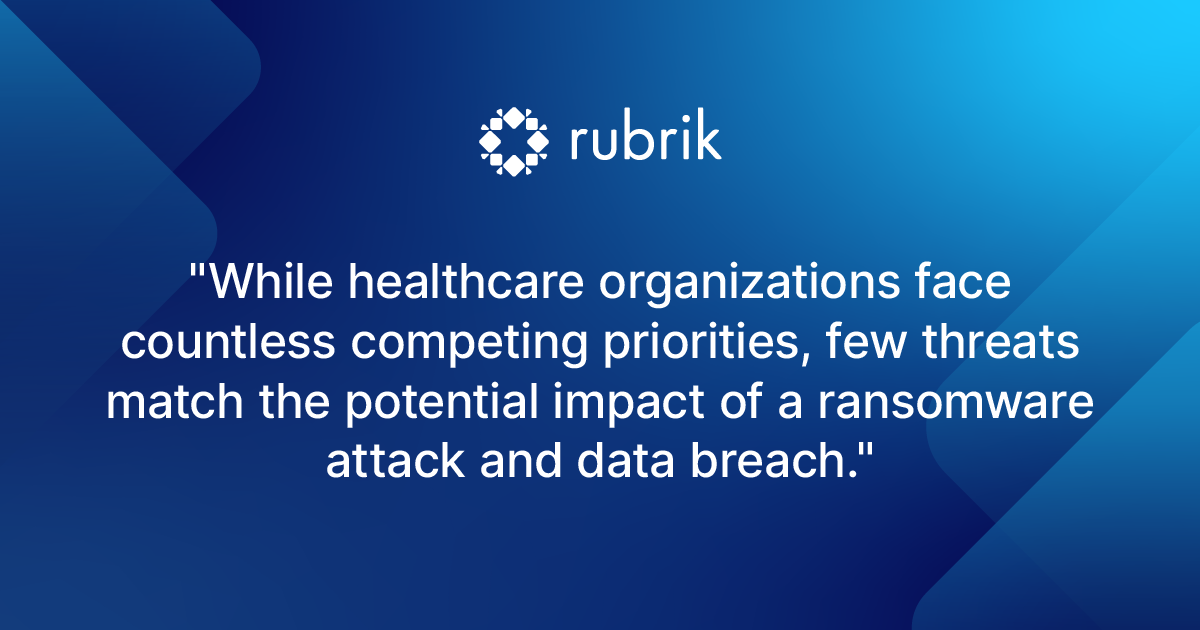With the continued increase in the frequency and impact of cyber attacks, healthcare providers are coming to realize that prevention alone is not enough. Cyber resilience in healthcare means being able to continue providing patient care even during cyber attacks—and is now an essential part of recovery planning.
This blog is the first entry in a series that will explain the evolution of recovery planning and why a new approach is needed. It will also include helpful tips to help your hospital keep the lights on when it matters the most.
This post focuses on why cyber resilience should be at the top of your priority list.
Zero Hour: The Chaotic Moments After a Cyberattack
It always happens at the worst moment—during holidays, weekends, or late evenings. Cybercriminals deliberately strike when IT teams are least likely to respond quickly, silently penetrating an organization's defenses and stealing sensitive data.
Leaders who've experienced these attacks can describe the overwhelming fallout. Physical security systems can fail, requiring manual staffing at doorways. Electronic workflows vanish, causing dangerous delays in lab results and imaging. Software safeguards disappear from clinical processes, eliminating crucial verification steps. Communication breakdowns introduce friction into every interaction.
So much can go wrong during this chaos that it can be difficult to figure out how to start fixing things. In one case, an organization had to urgently restore facility automation systems before pipes burst and rendered the building uninhabitable. With so much focus on patient care, it may be easy to overlook such a mundane priority; but it immediately overshadowed other critical concerns.
So it’s essential to know which tasks to tackle first.
Beyond Generational Shifts
Many attribute healthcare's technology dependence to generational changes—younger clinicians who never learned bespoke paper processes, for example. But this overlooks a larger reality: over decades, healthcare organizations have evolved in thousands ways that created this dependence. In the modern era of patient care:
Patients present with greater acuity and more complex conditions
Standard of care now includes vastly more technical interventions and monitoring
Facility designs have evolved away from centralized oversight models
Staffing ratios have increased as electronic systems enabled efficiency
Documentation requirements have multiplied exponentially
Reference materials and tools for manual calculations are no longer readily available
Medication dispensing systems have become increasingly automated
The variety and complexity of medications have proliferated
This migration toward technology dependence extends beyond patient care. Security personnel have been replaced by proximity readers, supply chain workers by automated systems, and even basic environmental controls may rely on functioning networks. The question becomes: how many functions in your organization require someone to first log into a computer?
Why Focus on Cyber Resilience?
While healthcare organizations face countless competing priorities, few threats match the potential impact of a ransomware attack and data breach. Financial consequences can unfold over a decade, with aggregated costs comparable to losing an entire facility—tens to hundreds of millions for smaller systems, potentially exceeding a billion dollars for the largest organizations.
These aren't theoretical concerns. SMP Health publicly cited their ransomware attack as the determining factor in declaring bankruptcy and shutting down. Unable to bill for three months, the already financially strained system couldn't survive.
In response, healthcare organizations worldwide are recognizing the need for cyber resilience. This mirrors a broader philosophical shift happening in clinical care, where providers are moving beyond just diagnosing and treating illness toward preventing disease and promoting wellness. Similarly, IT departments must move beyond prevention-only security strategies to develop capabilities for diagnosing, treating, and recovering from inevitable cyber incidents.
Healthcare organizations are allocating emergency funding as regulators signal stronger requirements. Even regulators recognize the need for cyber resilience and are proposing good first steps. The U.S. Health and Human Services department, for example, has proposed HIPAA updates that include ambitious mandates like maintaining ongoing documentation of personal health information (PHI) locations, identifying critical applications and their relative priorities, and developing plans to recover essential systems within 72 hours.
But the cyber security challenge to healthcare will require more than new regulatory pressure. It will require all hands on deck.
The Coordination Challenge
Responding effectively to a cyber attack requires coordination across disciplines—from facilities to legal, marketing to clinical staff and IT. Unfortunately, at the outset of an attack the unknowns vastly outnumber available answers. And no single team possesses the full context to act unilaterally.
Traditional IT disaster recovery plans are focused on response to a natural disaster and rarely address the unique challenges of cyber attacks. In the case of a malicious incursion, the fundamental issue isn't simply restoring systems, but dealing with loss of trust. Without knowing how attackers gained access or what they changed, everything becomes suspect until extensive forensic analysis is complete.
Despite these challenges, a body of knowledge is emerging from healthcare organizations that have weathered attacks, IT professionals who've responded, supporting vendors, and public agencies. The first critical step is developing a common understanding across these diverse stakeholders regarding:
What happens during an attack
Potential organizational impacts
Each team's responsibilities
Realistic recovery timelines
Interdependencies between departments
The question isn't whether your organization will face a cyber attack, but how effectively you'll respond when it inevitably happens. Rubrik has solutions for healthcare organizations that can build cyber resilience now—helping you mitigate impacts, reduce recovery time, and potentially save your organization from financial devastation when that dreaded late-night call finally comes.


